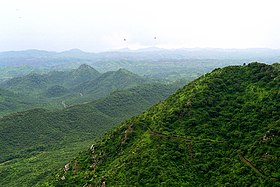Aravali Range
| Aravalli Range | |
|---|---|
| अरावली | |

The Aravali Range in Rajasthan
|
|
| Highest point | |
| Peak | Guru Shikhar,Mount Abu |
| Elevation | 1,722 m (5,650 ft) |
| Coordinates | 24°35′33″N 74°42′30″E / 24.59250°N 74.70833°E |
| Dimensions | |
| Length | 692 km (430 mi) |
| Geography | |
| Country |
|
| States | Rajasthan, Haryana, Delhi and Gujarat |
| Settlement | Mount Abu(Sirohi) |
| Range coordinates | 25°00′N 73°30′E / 25°N 73.5°ECoordinates: 25°00′N 73°30′E / 25°N 73.5°E |
The Aravalli Range (Hindi: अरावली, lit. 'line of peaks') is a range of mountains in western India running approximately 692 km (430 mi) in a northeastern direction across the Indian states of Gujarat, Rajasthan, and Haryana, ending in Delhi.
The Aravalli range are the oldest fold mountains in India. The northern end of the range continues as isolated hills and rocky ridges into Haryana state, ending in Delhi. The famous Delhi Ridge is the last leg of the Aravalli Range, which traverses through South Delhi and terminates into Central Delhi where Raisina hill is its last extension. It is one of the worlds' oldest mountain ranges. It dates back to a pre-Indian subcontinental collision with the mainland Eurasian Plate. The southern end is at Palanpur near Ahmedabad, Gujarat. The highest peak is Guru Shikhar in Mount Abu in Sirohi,Rajasthan. Rising to 5650 feet (1722 meters), it lies near the south-western extremity of the range, close to the border with Gujarat state. The city of Udaipur with its lakes lies on the south slope of the range in Rajasthan. Numerous rivers rise amidst the ranges including the Banas River, the Luni River, the Sahibi, the Sakhi, and the Sabarmati River.Chambal and Luni are two main rivers that flow through Rajasthan. The Aravalli Range is the eroded stub of a range of ancient folded mountains. The range rose in a Precambrian event called the Aravalli-Delhi orogen. The range joins two of the ancient segments that make up the Indian craton, the Marwar segment to the northwest of the range, and the Bundelkhand segment to the southeast. Old fold mountains are characterized by having stopped growing higher due to the cessation of upward thrust caused by the stopping of movement of the tectonic plates in the Earth's crust below them. In ancient times they were extremely high but since have worn down almost completely by millions of years of weathering. In contrast, the Himalayas are continuously rising young fold mountains of today.
...
Wikipedia

